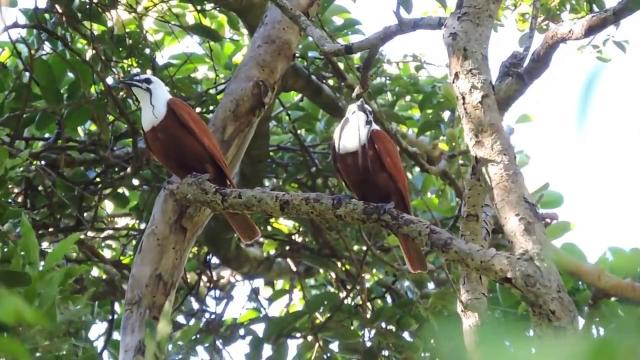You walk alone through a foggy forest with nothing but your day bag and binoculars. Birds and insects call quietly as they fly above and creep below. Suddenly, you hear a piercing, metallic alarm like nothing else in nature, followed by an even higher squeal—it sounds like microphone feedback, and it only grows louder as you continue walking.
Then, you spot it. A creature with an unsettlingly wide-open mouth and flaps of flesh dangling from its face. It’s a being that would be at home in a Silent Hill video game.
This thing is neither spook nor spirit. You’ve found the three-wattled bellbird, the haunted-looking denizen of Central American cloud forests and possibly the loudest bird in the world. But what is this creature? Why and how does it make its ear-shattering, soul-chilling sound?
“Some people mistake its call for carpentry work,” Debra Hamilton, executive director of the Monteverde Institute in Costa Rica, told Gizmodo. “Tourists complain to [hotel] receptionists.”
The three-wattled bellbird can be found in Costa Rica, Panama, Nicaragua, and Honduras, breeding in the mountain cloud forests but found at lower altitudes throughout the year. The forests really are foggy: “Some people would call it that creepy fog you always see at a haunted house—it rolls in and surrounds you,” said Hamilton.
It appears that the males of this species use their piercing calls to defend their territories, much like a dog might growl, as well as to attract female mates to their high perches, explained Hamilton. The wattles—those unsettling flesh flaps—are used in courtship displays and may continue to grow throughout the bird’s life.
The bird might take seven years to achieve its chestnut-and-white, three-wattled look; it appears brown-and-olive streaked until maturity. When one male lands on another’s perch, the defender will push the challenger to the edge of the branch and shriek directly into his ear. If the challenger can withstand the loud bonk and continues returning to the perch, he can overtake the branch and win the territory.
These birds are hard to spot, though easy to hear, as their loud shouts can carry for at least a kilometer during breeding season. They continue calling several times per minute, opening their mouth wide and heaving as if they’re about to vomit before emitting their immense bonk, a high pitch squeak, or a third, soft, washing machine-like noise.
The bird’s strange internal anatomy is probably responsible for the calls. Unlike humans, who have larynxes near the top of their tracheas, birds have a system called a syrinx at the bottom of their trachea, where it splits into either lung. Air vibrates as it passes a piece of cartilage at the base of the syrinx as well as its walls, creating noise.
“The syrinx of bellbirds is unique,” Richard Prum, evolutionary ornithologist at Yale, told Gizmodo. “The tracheobronchial junction,” where the trachea splits into the bronchi that lead to the lungs, “is a nearly spherical chamber that is covered with complex intrinsic musculature.” Though it’s still unclear how this structure creates the bonk, the three-wattled bellbird is the best-studied of the four bellbird species. You might find the calls of the white bellbird or bearded bellbird equally as strange.
But the bellbird isn’t born with its booming bonk, and scientists have studied how the three-wattled bellbird’s call changes as the bird ages. “You can hear young birds making inappropriate vocalisations that sound like an adolescent’s voice breaking,” said Prum.
The bird’s calls seem to be changing as a group, too. The third component of bellbird calls in Monteverde used to sound like a “chk chk chk,” but now the birds have all begun to add a more vocal quality. And birds in different regions make noises with different dialects, implying that they’re learning from one another and changing together, explained Hamilton.
This horror movie-esque creature is an essential resident of the cloud forest. These birds eat wild avocados, then spread the seeds by regurgitating them, though puking up an avocado seed perhaps adds to its freakiness.
And, like many other species, the three-wattled bellbird is at risk, as they lose their habitat to human development on the Pacific Ocean side of the mountains. They’re listed as vulnerable on the International Union for Conservation of Nature’s red list, though experts are concerned that their numbers are low enough to be considered endangered.
Sure, there are other birds who kill, who use tools, and who attack humans. But few have the unsettling appearance and spooky call of the three-wattled bellbird. And for that, they should be respected.
“This is not science fiction,” said Hamilton. “They’re the keepers of the forest.”
